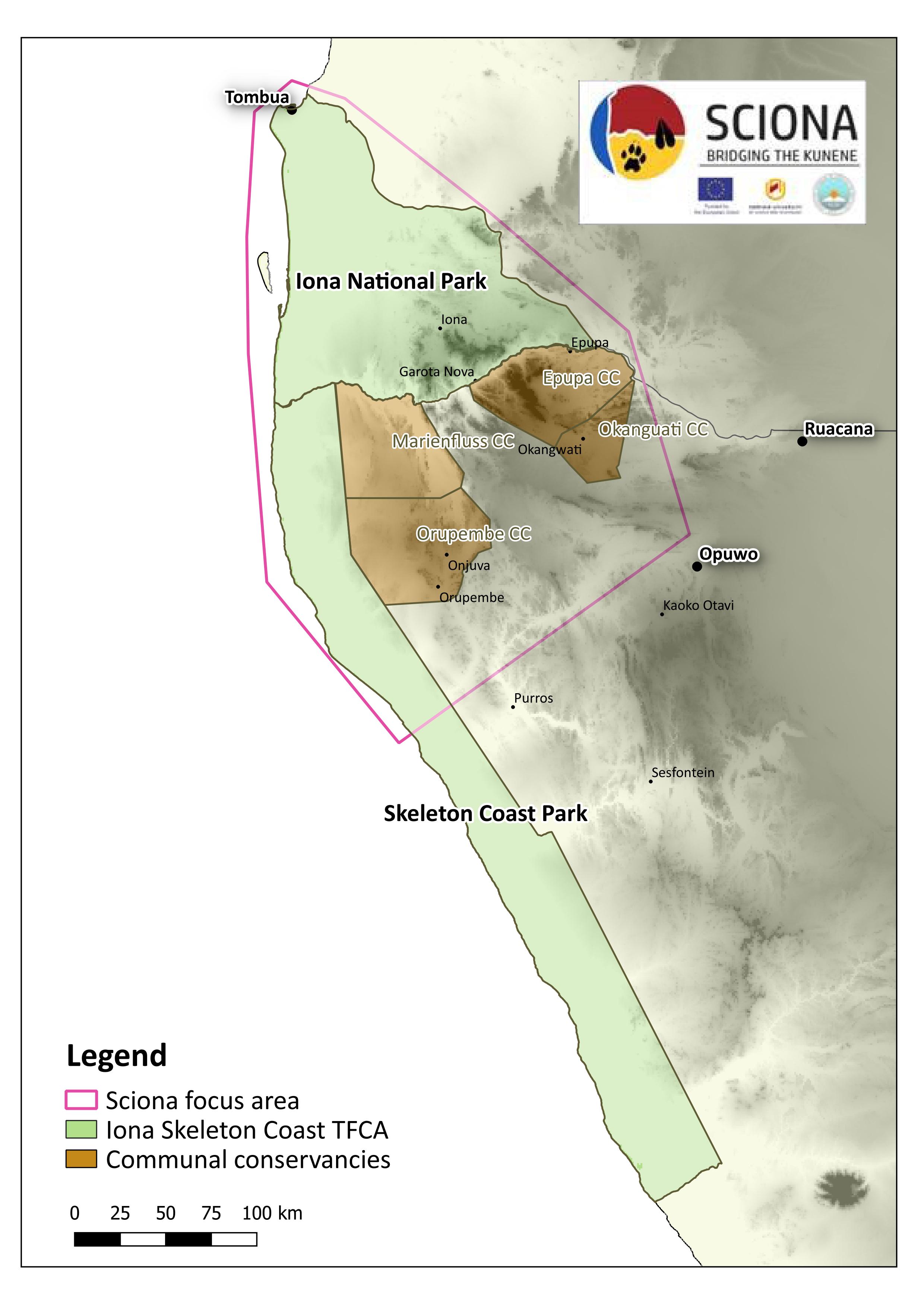About Iona - Skeleton Coast Transfrontier Park and the SCIONA project

The SCIONA project: Bridging the Kunene
Project title: Co-designing conservation technologies for the Iona-Skeleton Coast Transfrontier Conservation Area of Angola and Namibia
The SCIONA project is funded by the European Union (EuropeAid/156423/DD/ACT/Multi). The Namibia University of Science and Technology is leading the project in cooperation with the Instituto Superior de Ciências de Educação (ISCED) da Huíla, Angola (the Higher Institute of Education Sciences of Huíla, Angola). SCIONA started on 1 February 2018 and will last three years.
The SCIONA project aims to strengthen cross-border ecosystem management and wildlife protection in the Iona – Skeleton Coast Transfrontier Conservation Area (TFCA) through co-designing and implementing conservation monitoring technology with the park authorities and surrounding communities. The SCIONA project builds on the Namibian experiences with community involvement in ecotourism and conservation. Namibia has been at the forefront of devolving natural resource management authority to the local communities through the legally mandated Community-based Natural Resource Management (CBNRM) programme.
Under stable political conditions within an enabling policy environment, Namibia’s Skeleton Coast National Park and the adjacent conservancies have seen a positive growth of wildlife populations over the past 40 years. As the Namibian communities also rely on subsistence cattle and goat farming, they are particularly vulnerable to conflicts with predators such as lion, hyena, leopard, cheetah and crocodile. In contrast, Iona National Park in Angola has reduced wildlife populations and saw the encroachment of human populations into its sensitive habitats because of the recent civil war and subsequent lack of institutional and financial support. Increased human-wildlife conflict incidents are expected in Iona once biodiversity recovers and migration takes place from the Skeleton Coast and surrounding communal conservancies.
Download SCIONA flyer in English
Download SCIONA folheto em Português
Iona – Skeleton Coast TFCA
The Iona – Skeleton Coast Transfrontier Conservation Area (TFCA) is one of the larger transboundary conservation areas in southern Africa. It connects the Namib Desert ecosystem’s northern extent in Namibia and southern Angola and provides unique eco-tourism opportunities with its marine and terrestrial wildlife, impressive mountains, sand dunes, and surrounding indigenous Himba communities. The Namibian Skeleton Coast National Park and Angolan Iona National Park share several unique species, some found nowhere else on earth, including black-faced impala, desert dwelling elephants, the desert lion, black rhinos and the remarkable Welwitschia mirabilis plant. The two countries and parks are separated by the Kunene River, which provides an oasis in this arid ecosystem. The Kunene River mouth which flows into the Atlantic Ocean is the second most species-rich coastal wetland of Namibia (Simmons et al., 1993).
Compared to other TFCA’s in the region, the area has little viable agricultural land, lacks industrial development and has a low population density. Surrounding communities, including the Himba, have seen little benefit from their proximity to the TFCA and cross-border management of the conservation area has been limited. The area is remote and inaccessible due to rugged mountainous terrain as well as large sand dune dominated areas. The TFCA mainly relies on basic institutional structures, which are insufficient and result in poor ecosystem management and inadequate wildlife law enforcement. This is reflected by overfishing, poaching - including organised commercial rhino poaching, habitat destruction, illegal mining, flooding, animal out-migration and local species extinction, threatening the sustainable future of the transboundary park.
Under stable political conditions within an enabling policy environment, Namibia’s Skeleton Coast National Park and the adjacent conservancies have seen a positive growth of wildlife populations over the past 40 years (Nuulimba and Taylor, 2015; Owen-Smith, 2010). As the Namibian communities also rely on subsistence cattle and goat farming, they are particularly vulnerable to conflicts with predators such as lion, hyena, leopard, cheetah and crocodile. In contrast, Iona National Park in Angola has reduced wildlife populations and has seen the encroachment of human populations into its sensitive habitats because of the recent civil war and subsequent lack of institutional and financial support. Increased human-wildlife conflict incidents are expected in Iona once biodiversity recovers and wildlife migration takes place from the Skeleton Coast National Park and surrounding communal conservancies.
Angola and Namibia sign MoA on 3 May 2018: Iona – Skeleton Coast becomes a fully established TFCA
